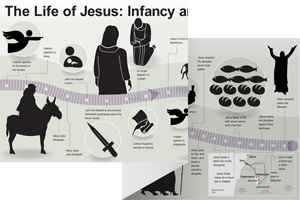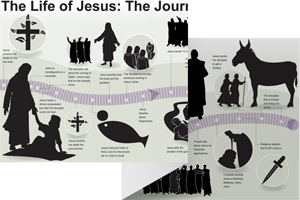9:1–6 In 6:13–16, Luke describes Jesus’ call of the Twelve to discipleship. Here, he records their commissioning as apostles—representatives sent out to proclaim the message that Jesus has inaugurated the kingdom of God. There are parallel accounts in the other Synoptic Gospels (compare Matt 10:1–14; Mark 6:6–13). |
9:1 authority over all the demons and to cure diseases These powerful signs will show the validity of the disciples’ proclamation of the kingdom of God.
9:3 Take along nothing for the journey They were to rely on God for their provisions.
9:4 stay there and depart from there The Twelve should not be concerned with procuring better accommodations, which would be offensive to their hosts.
9:5 shake off the dust from your feet A sign of protest and a warning of impending judgment (compare Acts 13:51; 18:6).
9:7–9 Some people regarded Jesus as John the Baptist risen from the dead; others viewed Him as the ot prophet Elijah, who was expected to return someday (Mal 4:5). Herod, |
 Political Leaders in the New Testament Table
Political Leaders in the New Testament Table
9:8 Elijah had appeared See note on Luke 9:19.
9:9 he was wanting to see him Herod’s curiosity is finally satisfied when Pilate sends Jesus to Herod (23:6–12).
9:10–17 This section describes the return of the Twelve and the feeding of the 5,000. |
9:10 And when they returned Luke resumes the narrative from Luke 9:6.
Bethsaida A village near Capernaum and the hometown of Peter, Andrew, and Philip (John 1:44).
and the hometown of Peter, Andrew, and Philip (John 1:44).
9:13 You give them something Jesus sets the stage for the miracle to follow.
no more than five loaves and two fish This response highlights that Jesus’ instruction must have seemed absurd to the apostles.
9:14 about five thousand men This estimate does not include women and children (compare Matt 14:21).
Jesus Feeds 5,000 People | |||
9:16 gave thanks and broke them and began giving See note on Matt 14:19.
9:18–20 In light of the earlier discussion about Jesus’ identity (Luke 9:7–9), Jesus asks His disciples what they have heard people saying. Then He asks for their opinion, and Peter responds correctly: Jesus is Yahweh’s Messiah (compare Matt 16:13–19; Mark 8:27–29). |
 Jesus’ Declaration at Caesarea Philippi
Jesus’ Declaration at Caesarea Philippi
9:18 Who do the crowds say that I am In Matthew, Jesus refers to the Son of Man when He asks this question, associating this apocalyptic, messianic figure with Himself (Matt 16:13; compare Mt 8:20 and note).
9:19 Elijah The ot prophet Malachi had foretold that the return of Elijah would precede the day of judgment (Mal 4:5). Although Jesus’ ministry may be compared to Elijah’s, who was prophesied by Malachi as preceding the day of judgment, John the Baptist was the primary fulfillment of that prophecy (compare Matt 16:14; 17:11 and note).
 Jesus and His Witnesses as Prophets in Luke—Acts
Jesus and His Witnesses as Prophets in Luke—Acts
9:20 The Christ of God Peter, perhaps acting as the group’s spokesman, identifies Jesus as God’s anointed one (see Luke 4:17–21).
 Jesus’ Declaration at Caesarea Philippi
Jesus’ Declaration at Caesarea Philippi
9:21–22 As in Matthew and Mark, Peter’s confession is followed immediately by Jesus’ first prediction of His death and resurrection (compare Matt 16:20–21; Mark 8:30–31). |
9:21 to tell this to no one Following His resurrection, Jesus’ disciples would be commissioned to make known explicitly what His signs and wonders revealed—Jesus’ identity as God’s Son and anointed one. Compare Luke 8:56 and note.
9:23–27 This is Jesus’ first discussion in Luke about the cost of discipleship (compare Matt 16:24–28; Mark 8:34–9:1). Jesus teaches more fully about this theme in Luke 14:25–35. |
9:23 deny himself Refers to setting aside one’s interests for the sake of God’s kingdom.
take up his cross every day Jesus’ disciples must be willing to follow Him every day, no matter what the cost. See note on Matt 10:38.
9:24 will lose it By seeking to avoid the potential hardships associated with following Jesus, a person ends up losing his or her life.
will save it Those who embrace Jesus’ call to discipleship—including the difficulties it brings—will be saved (compare John 3:16–17).
9:26 Son of Man See note on Matt 8:20; compare Luke 5:24; 6:22; 7:34; 9:22.
9:27 until they see the kingdom The precise meaning of Jesus’ statement here is difficult to determine. See note on Matt 16:28.
9:28–36 Jesus ascends a mountain to pray and is transformed into His heavenly glory. Parallel accounts appear in the other Synoptic Gospels (Matt 17:1–9; Mark 9:2–10). |
9:28 Peter and John and James See note on 8:51.
the mountain Luke’s account offers few geographical clues, but Matthew appears to place the transfiguration near Caesarea Philippi, a city located at the base of Mount Hermon, roughly 25 miles north of the Sea of Galilee. Another possibility is Mount Tabor,
roughly 25 miles north of the Sea of Galilee. Another possibility is Mount Tabor, southwest of the Sea of Galilee. See note on Matt 17:1.
southwest of the Sea of Galilee. See note on Matt 17:1.
9:29 the appearance of His face became different Recalls Moses’ change in appearance when he met with God (Exod 34:29–30).
9:30 Moses and Elijah Moses received the law; Elijah was one of Israel’s great prophets. This scene portrays Jesus’ ministry as fulfilling those traditions. It also clarifies Jesus’ identity: He is not Elijah or another ancient prophet; He is the Messiah—He is God incarnate (compare Luke 1:29–38; 9:19–20).
9:31 speaking about his departure This element advances Luke’s portrayal of Jesus’ divine messiahship: Jesus knew what awaited Him in Jerusalem and that He would soon return to God the Father.
9:33 three shelters The Greek term used here refers to tents or another form of temporary dwelling.
9:34 cloud In the ot, God’s presence is often indicated by the appearance of a cloud (e.g., Exod 13:21–22; 19:9, 16; Ezek 10:4).
9:35 This is my Son For the second time in Luke, God directly affirms Jesus as His Son—the first being at Jesus’ baptism (Lk 3:22); Gabriel also proclaimed this to Mary (1:32). Here, the voice addresses the disciples rather than Jesus (compare 3:22).
9:37–43 After the disciples are unable to heal a demon-possessed boy, his father implores Jesus to intervene. After critiquing the present generation for its weak faith, Jesus casts out the evil spirit. Parallel passages occur in the other Synoptic Gospels (Matt 17:14–21; Mark 9:14–29). |
Jesus’ Miracles in Gentile Cities | |
Gadara/Gerasenes | |
Tyre and Sidon | |
Caesarea Philippi | |
Decapolis | |
9:40 they were not able Despite the power and authority the disciples received from Jesus (Luke 9:1), they cannot cast out the demon. In Mark’s account, Jesus explains their inability (Mark 9:28–29).
9:41 O unbelieving and perverted generation See Matt 17:17 and note.
Jesus Heals an Epileptic Boy | ||
9:44–45 In v. 22, Jesus predicted His death and resurrection; now He predicts His betrayal. Compare Matt 17:22–23; Mark 9:30–32. |
9:45 it was concealed from them This insight is not recorded by Matthew or Mark.
9:46–48 Jesus perceives the disciples arguing over which of them is the greatest. He explains that the least among them is the greatest in God’s kingdom. Compare Matt 18:1–5; Mark 9:33–37. |
9:46 might be greatest This debate is ironic in light of the preceding events, which showed the disciples to be limited in their power (Luke 9:40) and understanding (v. 45).
9:47 a child Graeco-Roman society regarded children as insignificant. Jesus calls the child to illustrate the reversal of values in God’s kingdom (compare 13:30; 14:12–14; Matt 18:2 and note).
9:49–50 Jesus tells His disciples not to hinder the ministry of others who follow Jesus differently than them. Compare Mark 9:38–41. |
9:50 not against you is for you The ministry of God’s kingdom is not exclusive to the Twelve; it is the responsibility of all of Jesus’ followers.
9:51–56 Departing Galilee for Jerusalem, Jesus attempts to take the direct route through Samaria. When the Samaritans refuse to welcome Him, James and John ask if He would like them to call down fire from heaven. Jesus rebukes His disciples and moves on. Luke is the only Gospel writer to include this account during Jesus’ journey to Jerusalem. |
9:51 for him to be taken up The Greek text here uses a noun (analēmpsis) that appears only this one time in the nt, but the related verb (analambanō) often refers to Jesus’ ascension to heaven (e.g., Acts 1:11; 1 Tim 3:16). Other verbs connoting upward movement are used in reference to Jesus’ crucifixion and resurrection (e.g., Luke 24:34; John 3:14; 12:32–33).
set his face to go to Jerusalem This marks a major turning point in Luke’s Gospel, as Jesus’ ministry shifts from Galilee and advances toward Jerusalem and the cross. The long section that starts here is sometimes called Luke’s travel narrative (Luke 9:51–19:27).
9:52 he sent messengers before him Probably due to the size of the crowd traveling with Him.
the Samaritans Jews and Samaritans typically had a mutual hostility, based on ethnic, religious, and political barriers. See note on 10:33; note on John 4:9.
typically had a mutual hostility, based on ethnic, religious, and political barriers. See note on 10:33; note on John 4:9.
9:53 he was determined to go to Jerusalem Samaritans worshiped on Mount Gerizim (compare John 4:20 and note). They viewed Jerusalem as an illegitimate center of worship and deterred Jewish pilgrims heading there from Galilee. Matthew seems to indicate that Jesus took a circuitous route to Jerusalem, crossing the Jordan River in order to avoid Samaria (see note on Matt 19:1).
9:54 fire to come down from heaven Reminiscent of Elijah (2 Kgs 1:9–16).
9:57–62 This episode combines several short sayings of Jesus. As He travels toward Jerusalem, people respond in various ways to His call for discipleship. Jesus emphasizes that His followers must be willing to face hardships and make sacrifices. Compare Matt 8:18–22. |
9:58 Son of Man Jesus’ most common way of referring to Himself (see note on Matt 8:20).
9:60 Leave the dead to bury their own dead The call to discipleship takes precedence over all other duties. See note on Matt 8:22.
9:62 on the plow and looks back Followers of Jesus must have a singular focus on the work of God’s kingdom. This may be an allusion to 1 Kgs 19:19–21.

|
About Faithlife Study BibleFaithlife Study Bible (FSB) is your guide to the ancient world of the Old and New Testaments, with study notes and articles that draw from a wide range of academic research. FSB helps you learn how to think about interpretation methods and issues so that you can gain a deeper understanding of the text. |
| Copyright |
Copyright 2012 Logos Bible Software. |
| Support Info | fsb |
 Loading…
Loading…


